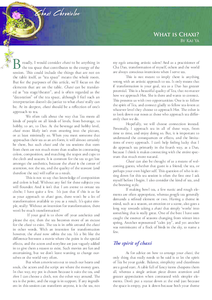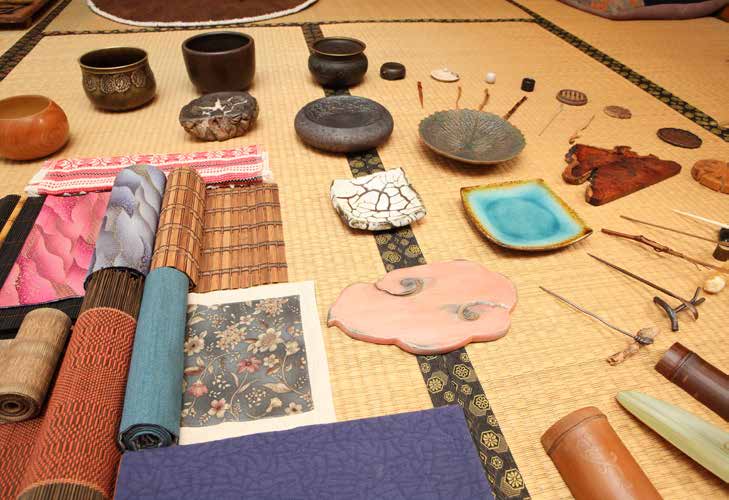
 |
|
Broadly, I would consider chaxi to be anything in the tea space that contributes to the energy of the session. This could include the things that are not on the table itself, as "tea space" means the whole room. But for the purposes of this article, we'll focus on the elements that are on the table. Chaxi can be translated as "tea stage/theater", and is often regarded as the "decoration" of the tea space, although I feel such an interpretation doesn't do justice to what chaxi really can be. At its deepest, chaxi should be a reflection of one's approach to tea.
We often talk about the way that Tea meets all kinds of people on all kinds of levels, from beverage, to hobby, to art, to Dao. At the beverage and hobby level, chaxi most likely isn't even entering into the picture, or at least minimally so. When you meet someone that approaches their tea as an art-form, it will almost certainly be there, but such chaxi and the tea sessions that stem from them are not much more than studies in contrasting colors, composition, and matching the teapot and cups to the cloth and saucers. It is common for the tea to get lost amongst the aesthetics, because the chaxi is the center of attention, not the tea, and the quality of the teaware (and therefore the tea) will suffer as a result.
This is not to say that knowledge of composition and colors is bad. Without any feel for these subjects you will flounder. And it isn't that I am averse to ornate tea cloths; I have quite a few. It's just that if this is as far as your approach to chaxi goes, there won't be a lot of transformation available to you as a result. It's quite simple, really: Without an intention for transformation, there won't be much transformation!
If your goal is to show off your aesthetics and please the eye, then the tea becomes more of an excuse for the chaxi to exist. The tea is in orbit around the chaxi in other words. With an intention for transformation however, the chaxi now orbits the tea. It's a bit like the difference between a movie where the point is the special effects, and the actors and storyline are just vaguely added in to give them a reason to exist. Such movies are fun and entertaining, but we don't leave wanting to change ourselves or the world very often.
But when a movie sets out to touch our hearts and souls, the actors and the script are where the money goes. In that way, my pot is chosen because it suits the tea, and then I can choose a cloth, not the other way around. The tea is the point, and the stage is in support. If any ingredient in this session can transform anyone, it is the tea, not my ego's amazing artistic talent! And as a practitioner of Cha Dao, transformation of myself, others and the world are always conscious intentions when I serve tea.
This is not meant to imply there is anything wrong with an artistic approach to tea. It only means that if transformation is your goal, tea as a Dao has greater potential. This is a beautiful quality of Tea, that no matter how we approach Her, She is there and wants to connect. This presents us with two opportunities: One is to follow the spirit of Tea, and connect gladly to fellow tea-lovers at whatever level they choose to approach Her. The other is to look down our noses at those who approach tea differently than we do.
Hopefully, we will choose connection instead. Personally, I approach tea in all of these ways, from time to time, and enjoy doing so. But, it is important to understand the consequences or effects, and the limitations of every approach. I can't help feeling lucky that I do approach tea primarily in the fourth way, as a Dao, because I think it makes connecting with the entire spectrum that much more natural.
Chaxi can also be thought of as a means of welcoming guests, whether that guest is a friend, the tea, or perhaps your own higher self. This question of who is sitting down for this tea session is often the first one I ask myself before I begin. I also consider the kind of tea, and the brewing style.
If making bowl tea, a few rustic and rough elements are often appropriate, whereas gongfu tea generally demands a refined element or two. Having a theme in mind, such as a season, an emotion or a scene, also goes a long way towards taking a chaxi that simply 'works' into something that is really great. One of the best I have seen caught the essence of seasons changing from winter into spring. Another represented "calm joy", and yet another was reminiscent of a flock of birds in the sky, to name a few.

As for advice on how to arrange your chaxi, the only thing that really needs to be said is to let the spirit of Tea be your guide. Balance, simplicity and cleanliness are a good start. A table full of fancy items cheapens them all, whereas a single artisan piece draws attention and greater appreciation when contrasted with simpler elements. Don't put a statue down at the end just because the space is empty, put it down because both your theme and the overall balance of the table demand it. Put it there because that statue represents the same spirit with which you plan to infuse this tea. The same with bonsai and flowers, or scattered flower-petals. Like a good piece of music, there should be space flowing between the notes, as well as moments of silence, and they all should be there for a reason or not be there at all!
Feeling obligated to fill all the space is a common mistake; so is going too far with color-matching everything, being unbalanced towards natural elements (rough wood and stones) or unbalanced towards manmade elements (metal and polished objects). The best way to avoid these pitfalls is to put everything down slowly, piece by piece.
Start by clearing the old chaxi away and cleaning the space. Sit down and meditate a few moments. I always sit down several times as the chaxi progresses. I take on the perspective of a guest, meditatively observing how this chaxi is influencing me, sensing distracting or unbalanced elements, and eliminating anything frivolous. One of the most important aspects of this is energetic. There should be a harmony present in the alchemy between all the elements that reaches in the same direction, without conflict.
In keeping with the spirit of tea, it is better to keep the chaxi as sparse and clean as possible. My advice is to start with the simplest of elements and make as many different chaxi as you can, before beginning to incorporate decorations and optional elements.
Approach chaxi in the same way we approach bowl tea and gongfu tea in this tradition: Get in touch with the roots of Tea first. Originally it was just leaves and water in a bowl. Make very simple chaxi until you can find the transformative power in a stick, a scoop, a pillow and a cloth, and then go into the gongfu - the more elaborate stuff. Then, that simplicity of spirit will be the backbone of all your chaxi, the roots for it to grow out of, and your chaxi will always find its balance. If you open your mind, and don't approach your chaxi with predetermined ideas, allowing the spirit of Tea to be your guide, you'll find a world full of possibilities...
"Those who cannot feel the littleness of great things in themselves, are apt to overlook the greatness of little things in others."
